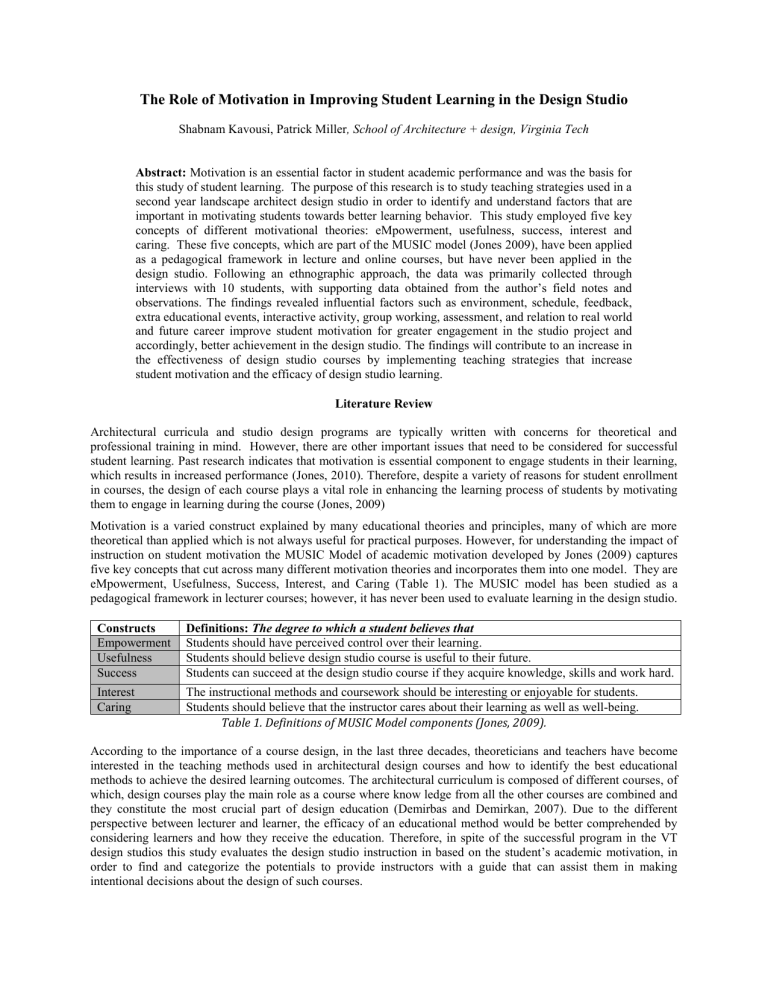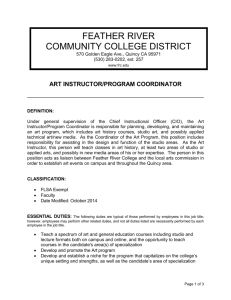2-page proposal file

The Role of Motivation in Improving Student Learning in the Design Studio
Shabnam Kavousi, Patrick Miller , School of Architecture + design, Virginia Tech
Abstract: Motivation is an essential factor in student academic performance and was the basis for this study of student learning. The purpose of this research is to study teaching strategies used in a second year landscape architect design studio in order to identify and understand factors that are important in motivating students towards better learning behavior. This study employed five key concepts of different motivational theories: eMpowerment, usefulness, success, interest and caring. These five concepts, which are part of the MUSIC model (Jones 2009), have been applied as a pedagogical framework in lecture and online courses, but have never been applied in the design studio. Following an ethnographic approach, the data was primarily collected through interviews with 10 students, with supporting data obtained from the author’s field notes and observations. The findings revealed influential factors such as environment, schedule, feedback, extra educational events, interactive activity, group working, assessment, and relation to real world and future career improve student motivation for greater engagement in the studio project and accordingly, better achievement in the design studio. The findings will contribute to an increase in the effectiveness of design studio courses by implementing teaching strategies that increase student motivation and the efficacy of design studio learning.
Literature Review
Architectural curricula and studio design programs are typically written with concerns for theoretical and professional training in mind. However, there are other important issues that need to be considered for successful student learning. Past research indicates that motivation is essential component to engage students in their learning, which results in increased performance (Jones, 2010). Therefore, despite a variety of reasons for student enrollment in courses, the design of each course plays a vital role in enhancing the learning process of students by motivating them to engage in learning during the course (Jones, 2009)
Motivation is a varied construct explained by many educational theories and principles, many of which are more theoretical than applied which is not always useful for practical purposes. However, for understanding the impact of instruction on student motivation the MUSIC Model of academic motivation developed by Jones (2009) captures five key concepts that cut across many different motivation theories and incorporates them into one model. They are eMpowerment, Usefulness, Success, Interest, and Caring (Table 1). The MUSIC model has been studied as a pedagogical framework in lecturer courses; however, it has never been used to evaluate learning in the design studio.
Constructs Definitions: The degree to which a student believes that
Empowerment Students should have perceived control over their learning.
Usefulness
Success
Students should believe design studio course is useful to their future.
Students can succeed at the design studio course if they acquire knowledge, skills and work hard.
Interest The instructional methods and coursework should be interesting or enjoyable for students.
Caring Students should believe that the instructor cares about their learning as well as well-being.
Table 1. Definitions of MUSIC Model components (Jones, 2009).
According to the importance of a course design, in the last three decades, theoreticians and teachers have become interested in the teaching methods used in architectural design courses and how to identify the best educational methods to achieve the desired learning outcomes. The architectural curriculum is composed of different courses, of which, design courses play the main role as a course where know ledge from all the other courses are combined and they constitute the most crucial part of design education (Demirbas and Demirkan, 2007). Due to the different perspective between lecturer and learner, the efficacy of an educational method would be better comprehended by considering learners and how they receive the education. Therefore, in spite of the successful program in the VT design studios this study evaluates the design studio instruction in based on the student’s academic motivation, in order to find and categorize the potentials to provide instructors with a guide that can assist them in making intentional decisions about the design of such courses.
Methodology
This study used an ethnographic methods for data collection that included interviews and field notes of observations.
In this sense, data collection was conducted using a standardized semi-structured open-ended interview with secondyear students. Ten respondents were interviewed at different times and locations based on their preferences.
Analysis of the study data was accomplished by systematically coding, sorting, categorizing and constructing themes from data. The findings were then compared to components of the MUSIC model to identify the influential factors, affecting student motivation.
Results and Discussion
The ethnographic approach allows the researcher to give voice to student evaluations and expectations, and to identify the potentials of current curriculum to improve student achievement. Using qualitative analysis of the student interviews, a coding scheme was generated that reflected respondents’ perceptions, as well as our integration of key themes (Bogdan & Biklen, 2007). Following the different components of the MUSIC model, the following observations were identified and categorized. Student empowerment was impacted less by instructor’s authority if the instructor showed flexibility against logical and rational requests from students and offered helpful suggestions instead of rigid comments. Moreover, assigning the same level of responsibility to students and preventing them from overshadowing other members’ empowerment in group working would reduce the negative impact of other students in this realm.The studio design course was perceived to be more useful for students when they learn technical skills necessary for a designer as well as social skills like, being able to present their work.
In this regard, collaboration between students through group work was improved while they learned how to present a design and deal with clients and their instructor expectations through pin-up sessions. In addition to acquiring knowledge and skills, and working hard, were other factors affecting student success in design studio. A clear schedule in the beginning of the semester provides a big picture of the whole semester for students and makes them familiar with the expectations and requirements. Further, continuous and encouragement and feedback from the instructors helped them move forward during the semester and finally a longitudinal, not cross sectional, assessment at the end of the semester enabled students to focus on the process, rather than a project. Interest in the studio design course was invigorated by providing a greater connection between the assignments and the experience of working as an architect , what happens in students’ future as their career in real world. Studio environment is unique. Other influential factors affecting students’ interest in the design course by encouraging more student proper interaction. Each student should believe that instructors care about his/her learning, as well as their wellbeing. In this regard, instructors needed to spend extra time and energy in the educational environment for helping students, holding workshops and pin up sessions. However, not just academic caring matters but also students’ feeling about personal caring could be satisfied by receiving responses and feedback with more attention and emotion from instructors. Other subjects, rather than academic issues, could also be discussed sometimes in order to change the atmosphere and make more connections more easily. Due to the unique condition and environment of studio design, students also could play a vital role in caring about others. Therefore, perspicuous critics and suggestions in a friendly environment and not in a purely competitive atmosphere highlight the caring attitude among students.
References
Bogdan, R. C., & Biklen, S. K. (2007). Qualitative research in education (5th ed.). Boston, MA: Allyn and Bacon.
Jones, B. D. (2009). Mot i vating students to engage in learning: The MUSIC Model of Academic Motivation.
International Journal of Teaching and Learning in Higher Education , 21(3), 272-285.
Jones, B. D. (2010). An examination of motivation model components in face-to-face and online instruction.
Electronic Journal of Research in Educational Psychology , 8(3), 915-944.
Jones, B. D., Ruff, C., Snyder, J. D., Petrich, B., & Koonce, C. (2012a). The effects of mind mapping activities on students’ motivation. International Journal for the Scholarship of Teaching and Learning, 6(1), 1-21.
Jones, B. D., Watson, J. M., Rakes, L., & Akalin, S. (2012b). Factors that impact students’ motivation in an online course: Using the MUSIC model of academic motivation. Journal of Teaching and Learning with
Technology, 1(1), 42-58.






